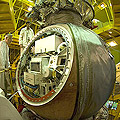| |||
Temperature fluctuations in a simple, single-component organic fluid on Earth (left) and onboard Foton-M3 (right) |
ESA PR 29-2007. In scientific research, there is great satisfaction when theoretical work is eventually supported by experimentation. Such was the case this week for a team of Italian and US scientists when they received preliminary confirmation of a 10-year-old theory from a fluid science experiment that is currently orbiting the Earth on the Foton-M3 spacecraft.
Although the Foton was only launched a week ago, the scientists are already very excited about the data they have received from their experiment, known as GRADFLEX (GRAdient-Driven FLuctuation EXperiment). The first results are qualitatively consistent with detailed theoretical predictions made over the past decade.
All liquids experience minute fluctuations in temperature or concentration as a result of the different velocities of individual molecules. These fluctuations are usually so small that they are extremely difficult to observe.
| |||
The Foton-M3 spacecraft spends 12 days orbiting Earth |
Although the early research involved ground-based measurements, it was suggested that the fluctuations would become much more noticeable in a weightless environment. Now, thanks to the Foton mission, the opportunity to test this prediction has come about, and the results completely support the earlier forecast.
| |||
Concentration fluctuations for the Mixture fluid sample on Earth (left) and aboard Foton-M3 (right) |
To the delight of the science team, the images visually support the theoretical predictions by showing a very large increase in the size of the fluctuations. Data analysis has also shown that the amplitude of the fluctuations in temperature and concentration greatly increased.
“It is a rare event when a space mission is able to confirm a theoretical prediction in such record time,” said Olivier Minster, Head of ESA’s Physical Sciences Unit. “These results are important because they are the first verification of the effects forecast a decade ago.”
| |||
The Foton capsule is packed full with experiments |
“It may be that our results will influence other types of microgravity research, such as the growth of crystals. Our research may even lead to some new technological spin-offs,” said Professor Giglio.
GRADFLEX is one of 43 ESA scientific and technological experiments on board the 12-day Foton-M3 mission. The mission is scheduled to end on 26 September, when the re-entry capsule will return to Earth in Kazakhstan. The onboard experiments will be returned to their home institutions where the data will be carefully analysed over the coming months.







No comments:
Post a Comment